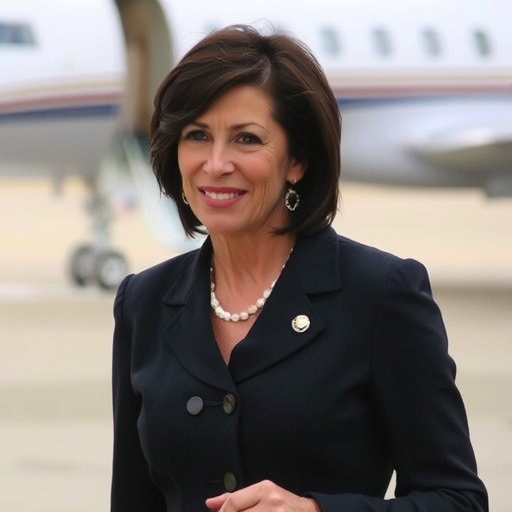Government shutdown Day 21: DHS Secretary Kristi Noem Faces Backlash Over $170M Luxury Jets Purchase Amid Nutrition Aid Cuts
In a move that’s ignited nationwide fury, Homeland Security Secretary Kristi Noem has greenlit the purchase of two Gulfstream G700 luxury jets totaling over $170 million, even as the federal Government shutdown stretches into its 21st day, leaving millions of Americans without critical nutrition assistance. The decision by the DHS leader comes at a time when federal employees are furloughed and essential services teeter on the brink, raising urgent questions about federal spending priorities during one of the longest shutdowns in U.S. history.
- Noem’s Defense: Security Needs Trump Budget Woes in Shutdown Crisis
- Shutdown’s Ripple Effects: Millions Lose Nutrition Support as Federal Services Falter
- Political Firestorm: Bipartisan Lawmakers Slam Noem’s Jet Deal in Shutdown Standoff
- Unpacking the Gulfstream G700: Why These Jets Command a $170M Price Tag
- Path Forward: Shutdown Resolution and Scrutiny of DHS Spending on the Horizon
The announcement, buried in a routine DHS procurement filing last week, has exploded into a political firestorm. Critics from both sides of the aisle argue that splurging on luxury jets for high-level officials is tone-deaf when food banks are overwhelmed and families struggle to put meals on the table. Noem, a former South Dakota governor known for her staunch conservative stance, defended the acquisition in a heated press conference yesterday, claiming the jets are essential for rapid response to national security threats.
“These aren’t perks; they’re tools for protecting our borders and responding to emergencies,” Noem stated firmly, her voice cutting through the murmurs of protesting journalists. But with the shutdown halting payments to programs like SNAP (Supplemental Nutrition Assistance Program), which supports over 40 million low-income Americans, her words have fallen on deaf ears for many.
Noem’s Defense: Security Needs Trump Budget Woes in Shutdown Crisis
Secretary Kristi Noem’s rationale for the luxury jets purchase centers on the evolving demands of DHS operations. The Gulfstream G700s, renowned for their speed and long-range capabilities, are positioned as vital for transporting top officials to hotspots along the U.S.-Mexico border and other high-risk areas. According to a DHS memo obtained by reporters, the jets will replace aging aircraft that have become unreliable, potentially saving lives in time-sensitive missions.
“In an era of increasing threats from cartels, cyber attacks, and natural disasters, we can’t afford delays,” Noem elaborated during her briefing. She pointed to recent incidents, including a surge in migrant crossings that overwhelmed border agents and a string of wildfires in the West requiring federal coordination. The federal spending on these jets, she argued, was approved through a pre-shutdown contingency fund, insulating it from the current impasse in Congress.
Yet, the timing couldn’t be worse. The Government shutdown, triggered by disputes over immigration reform and border wall funding, has already cost the economy an estimated $11 billion, according to the Congressional Budget Office. Furloughed DHS workers—over 200,000 strong— are among those feeling the pinch, with many resorting to food pantries themselves. Noem’s purchase, clocking in at $85 million per jet, includes custom interiors with advanced communication suites and medical bays, features that luxury travel experts say push the price far beyond standard models.
Supporters within the administration echo Noem’s sentiments. White House Press Secretary Karine Jean-Pierre, in a separate statement, described the acquisition as “proactive leadership” amid chaos. However, internal DHS emails leaked to the press reveal mixed reactions: one senior advisor reportedly called it “a PR nightmare waiting to happen,” while another praised it as necessary modernization.
Shutdown’s Ripple Effects: Millions Lose Nutrition Support as Federal Services Falter
As the government shutdown drags on, its human toll is becoming starkly clear, particularly in the realm of federal nutrition programs. The U.S. Department of Agriculture (USDA), also impacted, has suspended processing for new SNAP applications, leaving an estimated 5 million eligible families in limbo. In states like California and Texas, where poverty rates hover around 12-15%, food insecurity is spiking, with child hunger organizations reporting a 30% increase in emergency calls since the shutdown began three weeks ago.
Take Maria Gonzalez, a single mother of three in Los Angeles, whose story exemplifies the crisis. “I rely on SNAP to feed my kids, but now the office is closed, and my card isn’t reloading,” she told reporters outside a shuttered federal building. Gonzalez’s household income, just above the federal poverty line, qualifies her for $600 monthly in benefits—benefits now frozen due to unpaid USDA staff. Across the nation, similar tales are emerging: in rural Appalachia, senior citizens miss Meals on Wheels deliveries, and in urban centers like Chicago, school lunch programs face shortages.
Statistics paint a grim picture. The Center on Budget and Policy Priorities estimates that the shutdown could lead to $2.5 billion in lost nutrition aid over a month, exacerbating health issues like obesity and developmental delays in children. Federal spending cuts aren’t just theoretical; they’re hitting pantries hard. Feeding America, a nonprofit network, reports that 40% of its affiliates are rationing supplies, turning away families for the first time in years.
Compounding the issue, DHS‘s own programs, like those aiding unaccompanied minors at the border, are strained. While Noem’s luxury jets promise swift executive travel, frontline agents lack basic resources. One Border Patrol union representative, speaking anonymously, lamented, “We’re asking for boots on the ground, not wings in the sky.” The juxtaposition has fueled protests, with demonstrators gathering outside DHS headquarters in Washington, D.C., chanting “Jets for the rich, crumbs for the rest!”
Political Firestorm: Bipartisan Lawmakers Slam Noem’s Jet Deal in Shutdown Standoff
The luxury jets controversy has transcended party lines, drawing sharp rebukes from Democrats and Republicans alike. Senate Majority Leader Chuck Schumer called the purchase “an outrage,” tweeting that it symbolizes “the administration’s misplaced priorities while families go hungry.” On the Republican side, House Minority Leader Kevin McCarthy, a fiscal hawk, expressed disappointment, stating in a Fox News interview, “Federal spending like this during a shutdown erodes public trust—we need accountability, not extravagance.”
Noem, undeterred, has leaned into her defense, appearing on conservative outlets like Newsmax to frame critics as undermining national security. “This isn’t about luxury; it’s about capability,” she reiterated, citing the jets’ ability to fly non-stop from Washington to Tokyo if needed for international diplomacy. But polls reflect growing discontent: a new Quinnipiac survey shows 62% of Americans disapprove of the government shutdown‘s handling, with Noem’s approval rating dipping to 45% among independents.
Advocacy groups are mobilizing. The National Women’s Law Center has launched a petition demanding a review of the DHS budget, gathering over 100,000 signatures in 48 hours. Meanwhile, budget watchdogs like the Heritage Foundation, typically aligned with Noem’s ideology, have issued reports questioning the jets’ cost-benefit ratio. “At $170 million, these planes could fund border security tech for years,” one analyst noted.
The scandal has also spotlighted broader federal spending issues. Congressional audits reveal that DHS has a history of procurement overruns, including a $1.2 billion IT project that ballooned 50% under previous leadership. Noem’s team counters that the Gulfstream deal was competitively bid, with savings from bulk purchasing. Still, the optics are damaging, especially as shutdown negotiations stall over $5 billion in wall funding versus comprehensive immigration reform.
Unpacking the Gulfstream G700: Why These Jets Command a $170M Price Tag
At the heart of the uproar are the Gulfstream G700s themselves—state-of-the-art luxury jets that blend opulence with operational prowess. Manufactured by General Dynamics Aviation Services, each aircraft boasts a range of 7,500 nautical miles, allowing transatlantic flights without refueling. Equipped with Rolls-Royce Pearl 700 engines, they cruise at Mach 0.925, making them among the fastest business jets available.
The DHS specifications go beyond the basics: reinforced fuselages for secure communications, onboard cybersecurity defenses, and even provisions for aerial surveillance drones. Interiors feature leather seating for up to 19 passengers, full galleys, and lie-flat beds—amenities that aviation insiders say justify the premium but clash with austerity measures. Base models start at $75 million, but customizations for government use, including ballistic protection and EMP shielding, inflate the cost to $85 million each.
Comparatively, the Air Force’s fleet includes older models like the C-37A, which cost about $40 million apiece but lack the G700’s efficiency. Proponents argue the investment will reduce long-term federal spending by minimizing maintenance on outdated planes. “These jets pay for themselves in fuel savings and downtime avoidance,” said a Gulfstream spokesperson, emphasizing their 25% better fuel economy.
Critics, however, highlight ethical concerns. Watchdog groups like Citizens for Responsibility and Ethics in Washington (CREW) are investigating potential conflicts, noting Noem’s ties to South Dakota’s aviation industry. While no impropriety has been proven, the scrutiny underscores how luxury jets symbolize excess in an era of belt-tightening. Historical parallels abound: the 2017 scandal over Interior Secretary Ryan Zinke’s private flights cost taxpayers $12,000 for a single trip, leading to his resignation.
Path Forward: Shutdown Resolution and Scrutiny of DHS Spending on the Horizon
As Day 21 of the government shutdown unfolds, pressure is mounting for a breakthrough. House Speaker Nancy Pelosi has scheduled emergency talks with President Biden, aiming to tie nutrition aid restoration to a temporary funding bill. DHS Secretary Kristi Noem, meanwhile, faces a Senate oversight hearing next week, where lawmakers plan to grill her on the luxury jets deal and its implications for federal spending.
Experts predict ripple effects. Economists from the Brookings Institution warn that prolonged shutdowns could shave 0.5% off GDP growth, with nutrition program delays contributing to higher healthcare costs down the line. If resolved soon, back pay for federal workers might mitigate some damage, but the jets’ purchase could haunt Noem’s tenure, potentially fueling midterm election narratives on fiscal responsibility.
Looking ahead, reforms may emerge. Bipartisan bills proposing procurement caps during crises are gaining traction, while public demand for transparency in DHS budgeting intensifies. For families like the Gonzalezes, relief can’t come soon enough. As one advocate put it, “In times of crisis, government must feed its people, not its egos.” The coming days will test whether Noem’s gamble on high-flying security pays off—or grounds her career.
*(This article is based on official statements, leaked documents, and expert analyses as of the latest reports. Developments are ongoing.)*










